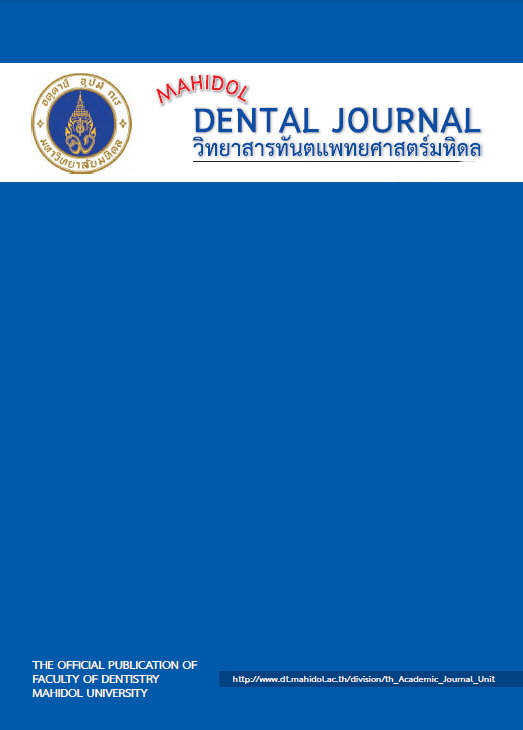Importance of patient’s position during oral prophylaxis: A simulated study in phantom head.
Main Article Content
Abstract
Objective: To study the relationship between amount and direction of water spraying from ultrasonic scaler tip and the position of phantom head while performing upper anterior teeth cleaning.
Materials and methods: Three black-dyed papers were placed around phantom head holding a velmix-cast securing plastic upper anterior teeth. Two types of ultrasonic scalers, magnetostrictive and piezoelectric, were activated on the upper anterior teeth in the phantom head which was adjusted at different angulations to the horizontal plane. Statistical difference was calculated to compare between the amount of water spreading from two scaler types and between the amounts of water spreading from ultrasonic scaler among different phantom head angulations. The direction of water spreading was explained by descriptive statistics using mean.
Results: The highest amount of water spreading from both scalers was measured at twelve o’ clock in every phantom head angulation except at 0º using Piezoelectric. The highest amount of water spreading was recorded when the phantom head was tilted by -10o from the horizontal plane and was significantly different from 0o and -20o (p <.05). The magnetostrictive scalers produced significantly more water spreading than the piezoelectric scalers in every position of the phantom head. There was a statistically significant difference between the amount of spreading water produced by the magnetostrictive scalers and piezoelectric scalers (p <.05) when the phantom head is positioned parallel to the floor (0o).
Conclusion: Angulation of the phantom head to the horizontal plane has an effect on the direction of water spreading around the phantom head. Piezoelectric scaler did produce less amount of water spreading than magnetostrictive one.
Article Details
References
2. Micik RE, Miller RL, Mazzarella MA, et al. Studies on dental aerobiology. I. Bacterial aerosols generated during dental procedures. J Dent Res 1969; 48: 49-56.
3. Hinds WC. Aerosol technology: properties, behavior, and measurement of airborne particles. New York: Wiley; 1982: 6.
4. Harrel SK, Barnes JB, Francisco RH. Aerosol and splatter contamination from the operating site during ultrasonic scaling. J Am Dent Assoc 1998; 129: 1241-49.
5. Holbrook WP, Muir KF, Macphee IT, et al. Bacteriological investigation of the aerosol from ultrasonic scalers. Br Dent J 1978; 144: 245-7.
6. Miller RL. Characteristics of blood-containing aerosols generated by common powered dental instruments. Am Ind Hyg Assoc J 1995; 56: 670-6.
7. Wilkins EM. Nonsurgical periodontal instrumentation. Clinical practice of the dental hygienist. 10 th ed. Philadelphia: Wolters Kluwer; 2009: 641-72.
8. Legnani P, Checchi L, Pelliccioni GA, et al. Atmospheric contamination during
dental procedures. Quintessence Int 1994; 25: 435-9
9. Miller RL, Micik RE, Ryge G, Able C. Studies of dental aerobiology: II. Microbialsplatter discharge from the oral cavity of dental patients. J Dent Res 1971; 50: 621-5.
10. Barnes JB, Harrel SK, Rivera-Hidalgo F. Blood contamination of the aerosols produced by in vivo use of ultrasonic scalers. J Periodontol 1998; 69: 434-8.
11. King TB, Muzzin KB, Berry CW, et al. The effectiveness of an aerosol reduction device for ultrasonic scalers. J Periodontol 1997; 68: 45-9.
12. Logothetis DD, Gross KB, Eberhart A, et al. Bacterial airborne contamination with air-polishing device. Gen Dent 1988; 36: 496-9.
13. Rautemaa R, Nordberg A, Wuolijoki-Saaristo K, Meurman JH. Bacterial aerosols in dental practice – a potential hospital infection problem? J Hosp Infect 2006; 64: 76-81.
14. Harrel SK, Molinari J. Aerosols and splatter in dentistry: A brief review of the literature and infection control implications. J Am Dent Assoc 2004; 135: 429-37.
15. Harrel SK, Barnes JB, Rivera-Hidalgo F. Reduction of aerosols produced by ultrasonic scalers. J Periodontal 1996; 67: 28-32.
16. Muir KF, Ross PW, etal. Reduction of microbial contamination from ultrasonic scalers.
Br Dent J 1978; 145: 76-8.
17. Logothetis DD, Martinez-Welles JM. Reducing bacterial aerosol contamination with a chlorhexidine gluconate pre-rinse. J Am Dent Assoc 1995; 126: 1634-9.


